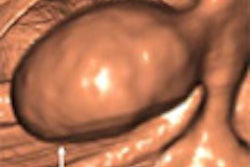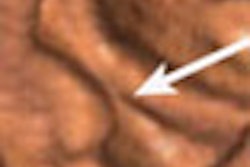AGRA - When Dr Sanjiv Sharma addressed the Indian Radiological and Imaging Association (IRIA) 20 years ago, he faced a small audience, some of whom reportedly "fell asleep," according to him. On Sunday, he presented his paper "Technique and interpretation of catheter coronary angiography" to a packed hall of peers and seniors.
Sharma is a professor and head of the department of cardiac radiology at the All India Institute of Medical Sciences, president of the Asia-Pacific Association of Cardiovascular and Intervention Radiology, and an authority on the subject of cardiology, with over 100 technical papers to his credit.
Focusing on the use of multislice CT, Sharma paper was a primer on the modality, including its capabilities, various issues regarding the technology, and how to address them. Sharma is convinced coronary imaging requires multiple views of the left ventricular area for evaluating anatomic abnormalities, morphological deficiencies, and calcification consequences of coronary artery abnormalities in the left ventricle.
The diagnostics currently in practice include catheter angiography, echocardiogram, and multislice imaging. Sharma feels the problems with cardiac imaging include wide variation in the densities of surrounding tissue and motion (pulsation, respiration, and rotation). Adding to this, the heart has an angulated, skewed anatomy tilted on all three axes. "All these translate to radiologists staying away from cardiology," Sharma added.
For cardiac imaging, the left coronary artery is of great interest as it supplies blood to the largest area of the body. Here accurate diagnostics could be the difference between life and death for the patient. The obliquity of the heart makes it problematic to pinpoint where the various vessels lie.
"Why are two views of the imaged area important?" Sharma asks. He then goes on to answer, "For a physician, a multiple angulated left ventricular view is a must. Even in cases of right ventricular artery (RCA) disease, diagonally opposite views are required."
The dominance of cardiology is classified into right dominant, co-dominant, and left dominant. The position of the posterior descending artery is also an important factor that cardiologists would expect from a radiologist.
An interesting aspect of cardiology problems in India and South East Asian countries not generally encountered in Europe and the U.S. is the affliction of atherosclerosis (nonspecific) being greater in women, and prevalence of Takayasu's arteritis and Kawasaki disease among the young -- vasculitis in children is especially frightening. To a lesser degree, cardio-radiologists should also focus on collagen vas.
Sharma identifies the diagnostic requirements in the angio morphology of stenoid cases as a) site, b) extent of lesion, c) severity (distal runoff), and d) dilatation. Ostial-distal left main may be treated as clinical, but a distal left main coronary artery must never be sent home without immediate correction.
Results are best and safe using CT, Sharma stated. When the LAD is most severe, the radiologist must assume a different management technique. Important management decisions are taken by the physician or surgeon based on the report.
Sharma said that evaluating angio morphology of stenosis is based on the following terms:
- Concentric versus eccentric
- Smooth versus irregular
- Relation to branch vessels
- Thrombosis
It is also important for physicians to know the extent of calcification and prognosticate, Sharma stated. For example, they should change management procedures for individual requirements when injecting clot-busting drugs.
With the ectasia of the coronary artery (an enlargement of the coronary by more than one-and-a-half times), the areas of focus are anomalous origin of calcification and anomalous origin of LAD from the right coronary artery. Significantly, the interarterial course of anomalous RCA and anomalous origin of LCA from the pulmonary artery are exposed by CT angiography, Sharma said.
Sharma avers that catheter angio is still the mainstay and the golden standard evaluation system for coronary heart diseases, since it allows doctors to look underneath the calcium, gives accurate measurement of high-grade stenosis, and offers unmatched lateral resolution. On the screen of detection appear hypokinesia, akinesia, and dyskinesia.
The future will see help at hand for mitral regurgitation, ventricular septal defects, and plaque quantification of regional valves. Hopefully, more radiologists will throng to the cardiac specialization to take up the challenge.
The morning session also saw excellent presentations by Dr Rolf Raaijmakers, "Cardiac MDCT: Clinical Applications," and "Perfusion Imaging in Myocardial Ischaemia" by Dr Bhavin Jhankaria. The former has good news: 4D images, 64-slice imaging show smaller lesions as clear images; Jhankaria sees the future in fusion with patho-analytic contrast-enhanced CMR. Whatever the future holds, cardiac radiology is going to be in the spotlight.
By Ravi Damodaran
AuntMinnieIndia.com contributing writer
January 24, 2005
Copyright © 2005 AuntMinnie.com



















